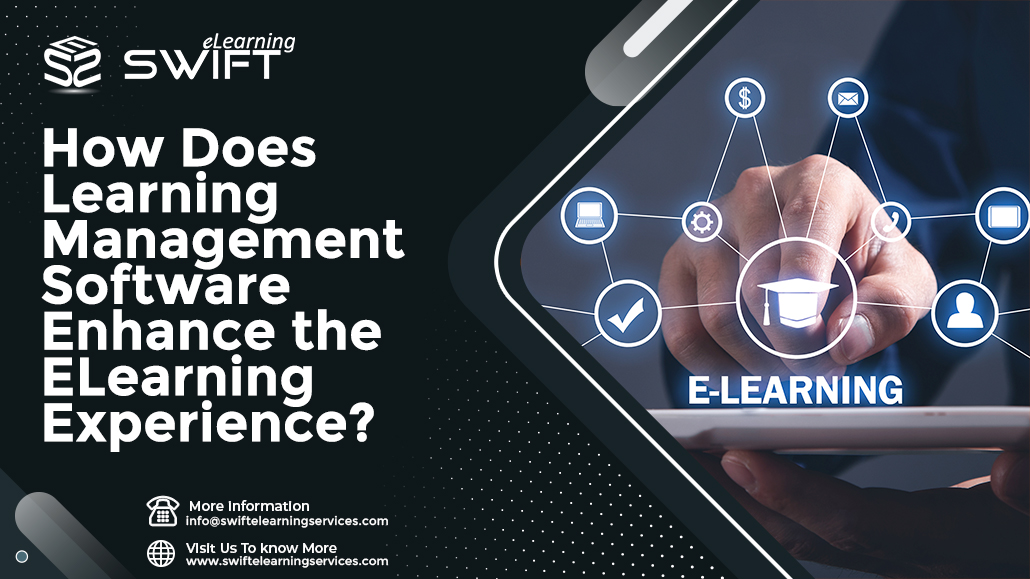How Does Learning Management Software Enhance the eLearning Experience?
In the rapidly evolving landscape of education, traditional methods of learning are gradually being replaced by digital alternatives.
ELearning has emerged as a versatile and effective way of acquiring knowledge, thanks to the convenience and flexibility it offers. Central to the success of eLearning is Learning Management Software (LMS), a technological solution that has revolutionized the way we approach education.
This article explores how Learning Management Software enhances the eLearning experience, providing learners and educators with a powerful tool to streamline, manage, and elevate the educational journey.
1. Understanding Learning Management Software
Learning Management Software (LMS), often referred to as a Learning Management System, is a robust and integrated platform designed to facilitate the administration, documentation, tracking, reporting, and delivery of educational courses, training programs, or learning materials.
LMS serves as the backbone of eLearning by providing educators and learners with a virtual space to interact, collaborate, and access resources. Its user-friendly interface, accessibility, and comprehensive features make it an indispensable tool in the realm of digital education.
2. Key Components of Learning Management Software
2.1 Course Creation and Management
LMS platforms provide tools for educators and trainers to design and structure courses. Content can be organized into modules, lessons, or units, creating a cohesive learning journey.
2.2 Content Delivery
LMS platforms support various formats of content delivery, including text documents, videos, presentations, quizzes, interactive assignments, and multimedia. This variety caters to different learning styles and preferences.
2.3 User Authentication and Enrolment
LMS ensures secure access by authenticating users through login credentials. Educators can enrol learners into specific courses, granting them appropriate permissions.
2.4 Assessment and Evaluation
LMS platforms enable the creation and management of assessments, quizzes, and exams. They provide instant feedback and often support automated grading, making assessment processes efficient.
2.5 Progress Tracking and Reporting
Learners and educators can track individual progress and performance. LMS generates reports and analytics that offer insights into completion rates, scores, and areas for improvement.
2.6 Communication and Collaboration
LMS platforms foster interaction through discussion boards, forums, chat functionalities, and messaging systems. Learners can engage with peers and educators, enhancing the learning experience.
2.7 Personalization and Adaptation
Modern LMS solutions incorporate adaptive learning technologies. By analysing learner behaviour and performance, the system can suggest personalized content and learning paths.
2.8 Integration
LMS platforms can integrate with other systems and tools, such as video conferencing, analytics, payment gateways, and authentication systems.
2.9 Gamification
Some LMS platforms include gamification elements like badges, leader boards, and rewards, enhancing engagement and motivation.
3. Enhancing the eLearning Experience with Learning Management Software (LMS)
3.1 Seamless Content Delivery
Learning Management Software allows educators to deliver content in various formats such as text, videos, quizzes, and interactive assignments. This versatility empowers learners with diverse learning styles to absorb information in ways that suit them best.
The organization of content into modules or units enables a structured learning path, ensuring that learners progress in a logical sequence, building on their knowledge gradually.
3.2 Flexibility and Accessibility
One of the standout advantages of eLearning through an LMS is the flexibility it offers. Learners can access course materials, lectures, and assignments at any time, from anywhere, as long as they have an internet connection. This is particularly beneficial for individuals who juggle work, family commitments, or other responsibilities alongside their education. Such accessibility breaks down geographical barriers, enabling participation from learners across the globe.
3.3 Personalized Learning Experience
Learning Management Software enhances eLearning by allowing educators to tailor content and assessments to individual learner needs. Adaptive learning techniques can be employed to deliver personalized content based on a learner’s progress and performance.
This approach ensures that each learner receives a customized experience, catering to their strengths, weaknesses, and pace of learning.
3.4 Engagement and Interactivity
Engagement is a critical factor in effective learning. Learning Management Software incorporates various interactive elements like quizzes, discussion boards, and multimedia content that keep learners engaged throughout the course.
Gamification features, such as badges and leaderboards, add an element of competition and achievement, motivating learners to actively participate and excel.
3.5 Progress Tracking and Assessment
Learning Management Software offers comprehensive tracking and assessment tools that enable both learners and educators to monitor progress.
Learners can keep tabs on their completion status, scores, and areas of improvement, fostering a sense of accountability. Educators can analyse data to identify trends, address challenges, and refine their teaching methods for better outcomes.
3.6 Collaborative Learning
LMS platforms facilitate collaborative learning through discussion forums, group projects, and peer assessment features. Learners from diverse backgrounds can interact, share insights, and engage in meaningful discussions, enriching the learning experience.
Collaboration not only fosters a sense of community but also exposes learners to different perspectives, enhancing critical thinking.
3.7 Instant Feedback and Communication
Learning Management Software enables timely and constructive feedback loops. Educators can provide feedback on assignments, quizzes, and assessments promptly, allowing learners to understand their mistakes and make necessary improvements.
Additionally, LMS platforms offer communication tools such as messaging and announcements, ensuring a seamless flow of information between educators and learners.
3.8 Resource Centralization
In traditional education, searching for learning resources can be time-consuming and frustrating.
Learning Management Software acts as a centralized repository for all course materials, eliminating the need for learners to scour the internet for relevant content. This organized approach simplifies the learning process, saving time and enhancing productivity.
3.9 Cost and Environmental Benefits
ELearning through Learning Management Software can significantly reduce costs associated with traditional classroom setups, such as travel, printed materials, and facility maintenance.
Moreover, it has a positive environmental impact by reducing paper consumption and carbon emissions associated with commuting.
4. Conclusion
In the dynamic landscape of education, Learning Management Software has emerged as a pivotal tool that enriches the eLearning experience. Its ability to seamlessly deliver content, provide flexibility, foster personalized learning, enhance engagement, track progress, and facilitate collaboration has revolutionized the way we learn and teach.
As technology continues to evolve, Learning Management Software is poised to further enhance the eLearning journey, making education more accessible, engaging, and effective than ever before. Whether you’re a student, an educator, or an institution, embracing Learning Management Software can unlock a world of opportunities in the realm of digital education.
Frequently Asked Questions (FAQs)
What is Learning Management Software (LMS)?
Learning Management Software, often referred to as LMS, is a robust platform that facilitates the administration, delivery, and management of educational courses and training programs. It serves as a virtual space where educators and learners interact, collaborate, and engage in the learning process.
How does Learning Management Software enhance eLearning?
Learning Management Software enhances eLearning by providing a centralized platform for content delivery, progress tracking, communication, and collaboration. It offers flexibility, personalized learning paths, and interactive elements that make the learning experience more engaging and effective.
What are the key features of Learning Management Software?
Learning Management Software includes features such as content creation and management, assessment tools, progress tracking, communication tools, collaboration features, personalized learning options, and integration capabilities with other systems.
How does Learning Management Software support personalized learning?
Learning Management Software supports personalized learning by analysing learner behaviour and performance. Based on this data, the system suggests customized content, learning paths, and assessments that cater to individual learner needs and preferences.
Can Learning Management Software track learner progress?
Yes, Learning Management Software can track learner progress through analytics and reporting features. Educators and learners can monitor completion rates, scores, and areas for improvement, enabling data-driven decision-making.
How does Learning Management Software enhance collaboration?
Learning Management Software enhances collaboration by offering discussion forums, chat functionalities, and group project features. Learners can interact with peers, share insights, and engage in meaningful discussions, enriching the overall learning experience.







Leave a Reply
Want to join the discussion?Feel free to contribute!